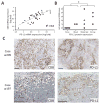Merkel polyomavirus-specific T cells fluctuate with merkel cell carcinoma burden and express therapeutically targetable PD-1 and Tim-3 exhaustion markers
- PMID: 23922299
- PMCID: PMC3790865
- DOI: 10.1158/1078-0432.CCR-13-0035
Merkel polyomavirus-specific T cells fluctuate with merkel cell carcinoma burden and express therapeutically targetable PD-1 and Tim-3 exhaustion markers
Abstract
Purpose: The persistent expression of Merkel cell polyomavirus (MCPyV) oncoproteins in Merkel cell carcinoma (MCC) provides a unique opportunity to characterize immune evasion mechanisms in human cancer. We isolated MCPyV-specific T cells and determined their frequency and functional status.
Experimental design: Multiparameter flow cytometry panels and HLA/peptide tetramers were used to identify and characterize T cells from tumors (n = 7) and blood (n = 18) of patients with MCC and control subjects (n = 10). PD-1 ligand (PD-L1) and CD8 expression within tumors were determined using mRNA profiling (n = 35) and immunohistochemistry (n = 13).
Results: MCPyV-specific CD8 T cells were detected directly ex vivo from the blood samples of 7 out of 11 (64%) patients with MCPyV-positive tumors. In contrast, 0 of 10 control subjects had detectable levels of these cells in their blood (P < 0.01). MCPyV-specific T cells in serial blood specimens increased with MCC disease progression and decreased with effective therapy. MCPyV-specific CD8 T cells and MCC-infiltrating lymphocytes expressed higher levels of therapeutically targetable PD-1 and Tim-3 inhibitory receptors compared with T cells specific to other human viruses (P < 0.01). PD-L1 was present in 9 of 13 (69%) MCCs and its expression was correlated with CD8-lymphocyte infiltration.
Conclusions: MCC-targeting T cells expand with tumor burden and express high levels of immune checkpoint receptors PD-1 and Tim-3. Reversal of these inhibitory pathways is therefore a promising therapeutic approach for this virus-driven cancer.
©2013 AACR.
Conflict of interest statement
The authors disclose no potential conflicts of interest.
Figures






References
Publication types
MeSH terms
Substances
Grants and funding
- F30 ES019463/ES/NIEHS NIH HHS/United States
- R01 CA162522/CA/NCI NIH HHS/United States
- NIH-R01CA162522/CA/NCI NIH HHS/United States
- K24 CA139052/CA/NCI NIH HHS/United States
- T32 ES007032/ES/NIEHS NIH HHS/United States
- NIH-RO1094019/PHS HHS/United States
- R01 CA176841/CA/NCI NIH HHS/United States
- RC2 CA147820/CA/NCI NIH HHS/United States
- NIH-K24-CA139052/CA/NCI NIH HHS/United States
- R01 AI094019/AI/NIAID NIH HHS/United States
- NIH-F30ES019463-01/ES/NIEHS NIH HHS/United States
- NIH-RC2CA147820/CA/NCI NIH HHS/United States
- T32 GM007266/GM/NIGMS NIH HHS/United States
LinkOut - more resources
Full Text Sources
Other Literature Sources
Research Materials

